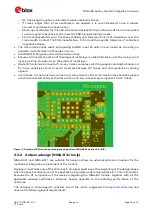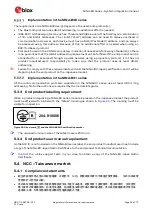
NINA-B3 series - System integration manual
UBX-17056748 - R13
Regulatory information and requirements
Page 48 of 72
C1-Public
EIRP is calculated as:
EIRP(dBm) = P
TX
(dBm)
–
L(dB) + G
TX
(dBi)
where, P
TX
is the output power of the transmitter, L is the path loss of the transmission line between
the transmitter and antenna, and G
TX
is the maximum gain of the transmit antenna. Consider the
following for each of these components:
•
Output power:
o
The output power setting of the NINA-B3 module. An end product user must not be able to
increase the setting above the 10 dBm EIRP limit, by sending configuration commands etc.
o
The operating temperature of the end product. The output power of a transmitter is typically
increased as the ambient temperature is lowered. The operating temperature range of NINA-
B3 is -40 to +85 °C, and across this range the output power can typically vary by 1 dB. The
output power at the lowest operating temperature (yielding the highest output power) must
be considered for the EIRP calculation.
•
Path loss
–
Long antenna cables or PCB traces, RF switches, etc. will attenuate the power reaching
the antenna. This path loss should be measured and taken into consideration for the EIRP
calculation.
•
Antenna gain - The maximum gain of the transmit antenna must be considered for the EIRP
calculation.
Implementation in the NINA-B31 series
In the u-connectXpress software, output power can be configured by using the Bluetooth
configuration AT command.
AT+UBTCFG=4,<output power>
The default output power setting (6), which typically corresponds to +6 dBm output power at room
temperature. This setting is based on the following assumptions:
•
-40 °C is the lowest operating temperature of the end product
•
The path loss is negligible
•
The maximum antenna gain of the end-product antenna is +3 dBi.
With these assumptions, the EIRP will be just below the 10 dBm limit. If, for instance the antenna gain
is i2 dBi and an antenna cable with 1 dB path loss is used, a higher output power setting could
be used.
☞
The maximum output power setting (8) typically corresponds to +8 dBm output power, though the
output power setting does not match the actual output power 1:1. Use a power meter or spectrum
analyzer to measure the actual output power before committing to a power setting.
Implementation in the NINA-B30 series
An integrator of the open CPU variant of the NINA-B3 series on the European market must make sure
that an end user cannot in any way configure the output power of the radio to 10 dBm EIRP or above.
5.1.4
Safety Compliance
⚠
In order to fulfill the EN 60950-1 safety standard, the NINA-B3 series modules must be supplied
with a Class-2 Limited Power Source.
















































